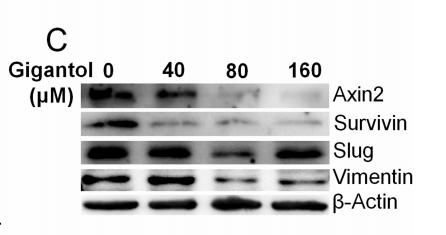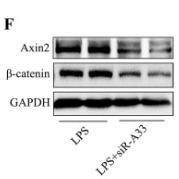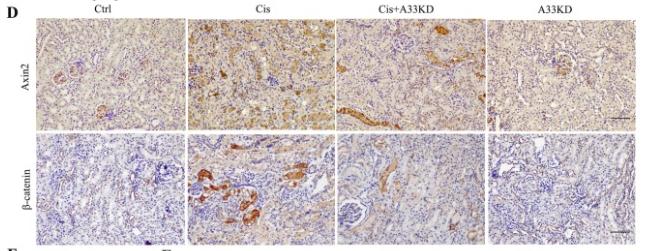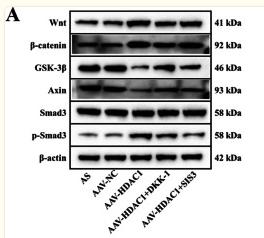AXIN2 Antibody - #DF6978
| Product: | AXIN2 Antibody |
| Catalog: | DF6978 |
| Description: | Rabbit polyclonal antibody to AXIN2 |
| Application: | WB IHC |
| Cited expt.: | WB, IHC |
| Reactivity: | Human, Mouse, Rat |
| Prediction: | Pig, Zebrafish, Bovine, Horse, Rabbit, Dog, Chicken |
| Mol.Wt.: | 93kDa; 94kD(Calculated). |
| Uniprot: | Q9Y2T1 |
| RRID: | AB_2838934 |
Related Downloads
Protocols
Product Info
*The optimal dilutions should be determined by the end user. For optimal experimental results, antibody reuse is not recommended.
*Tips:
WB: For western blot detection of denatured protein samples. IHC: For immunohistochemical detection of paraffin sections (IHC-p) or frozen sections (IHC-f) of tissue samples. IF/ICC: For immunofluorescence detection of cell samples. ELISA(peptide): For ELISA detection of antigenic peptide.
Cite Format: Affinity Biosciences Cat# DF6978, RRID:AB_2838934.
Fold/Unfold
Axil; Axin like protein; Axin-2; Axin-like protein; Axin2; AXIN2_HUMAN; Axis inhibition protein 2; Conductin; DKFZp781B0869; MGC10366; MGC126582;
Immunogens
A synthesized peptide derived from human AXIN2, corresponding to a region within N-terminal amino acids.
- Q9Y2T1 AXIN2_HUMAN:
- Protein BLAST With
- NCBI/
- ExPASy/
- Uniprot
MSSAMLVTCLPDPSSSFREDAPRPPVPGEEGETPPCQPGVGKGQVTKPMSVSSNTRRNEDGLGEPEGRASPDSPLTRWTKSLHSLLGDQDGAYLFRTFLEREKCVDTLDFWFACNGFRQMNLKDTKTLRVAKAIYKRYIENNSIVSKQLKPATKTYIRDGIKKQQIDSIMFDQAQTEIQSVMEENAYQMFLTSDIYLEYVRSGGENTAYMSNGGLGSLKVVCGYLPTLNEEEEWTCADFKCKLSPTVVGLSSKTLRATASVRSTETVDSGYRSFKRSDPVNPYHIGSGYVFAPATSANDSEISSDALTDDSMSMTDSSVDGIPPYRVGSKKQLQREMHRSVKANGQVSLPHFPRTHRLPKEMTPVEPATFAAELISRLEKLKLELESRHSLEERLQQIREDEEREGSELTLNSREGAPTQHPLSLLPSGSYEEDPQTILDDHLSRVLKTPGCQSPGVGRYSPRSRSPDHHHHHHSQYHSLLPPGGKLPPAAASPGACPLLGGKGFVTKQTTKHVHHHYIHHHAVPKTKEEIEAEATQRVHCFCPGGSEYYCYSKCKSHSKAPETMPSEQFGGSRGSTLPKRNGKGTEPGLALPAREGGAPGGAGALQLPREEGDRSQDVWQWMLESERQSKPKPHSAQSTKKAYPLESARSSPGERASRHHLWGGNSGHPRTTPRAHLFTQDPAMPPLTPPNTLAQLEEACRRLAEVSKPPKQRCCVASQQRDRNHSATVQTGATPFSNPSLAPEDHKEPKKLAGVHALQASELVVTYFFCGEEIPYRRMLKAQSLTLGHFKEQLSKKGNYRYYFKKASDEFACGAVFEEIWEDETVLPMYEGRILGKVERID
Predictions
Score>80(red) has high confidence and is suggested to be used for WB detection. *The prediction model is mainly based on the alignment of immunogen sequences, the results are for reference only, not as the basis of quality assurance.
High(score>80) Medium(80>score>50) Low(score<50) No confidence
Research Backgrounds
Inhibitor of the Wnt signaling pathway. Down-regulates beta-catenin. Probably facilitate the phosphorylation of beta-catenin and APC by GSK3B.
Probably phosphorylated by GSK3B and dephosphorylated by PP2A.
ADP-ribosylated by tankyrase TNKS and TNKS2. Poly-ADP-ribosylated protein is recognized by RNF146, followed by ubiquitination and subsequent activation of the Wnt signaling pathway.
Ubiquitinated by RNF146 when poly-ADP-ribosylated, leading to its degradation and subsequent activation of the Wnt signaling pathway. Deubiquitinated by USP34, deubiquitinated downstream of beta-catenin stabilization step: deubiquitination is important Wnt signaling to positively regulate beta-catenin (CTNBB1)-mediated transcription.
Cytoplasm.
Expressed in brain and lymphoblast.
The tankyrase-binding motif (also named TBD) is required for interaction with tankyrase TNKS and TNKS2.
Research Fields
· Cellular Processes > Cellular community - eukaryotes > Signaling pathways regulating pluripotency of stem cells. (View pathway)
· Environmental Information Processing > Signal transduction > Wnt signaling pathway. (View pathway)
· Environmental Information Processing > Signal transduction > Hippo signaling pathway. (View pathway)
· Human Diseases > Infectious diseases: Viral > Human papillomavirus infection.
· Human Diseases > Cancers: Overview > Pathways in cancer. (View pathway)
· Human Diseases > Cancers: Specific types > Colorectal cancer. (View pathway)
· Human Diseases > Cancers: Specific types > Endometrial cancer. (View pathway)
· Human Diseases > Cancers: Specific types > Basal cell carcinoma. (View pathway)
· Human Diseases > Cancers: Specific types > Breast cancer. (View pathway)
· Human Diseases > Cancers: Specific types > Hepatocellular carcinoma. (View pathway)
· Human Diseases > Cancers: Specific types > Gastric cancer. (View pathway)
References
Application: WB Species: Mouse Sample: bladder tissues
Application: WB Species: Mice Sample: pTEC cells
Application: IHC Species: Mice Sample:
Application: WB Species: goose Sample: dermal fibroblast cells
Application: WB Species: Human Sample: AS fibroblasts
Application: WB Species: Human Sample: Bladder cancer cell
Restrictive clause
Affinity Biosciences tests all products strictly. Citations are provided as a resource for additional applications that have not been validated by Affinity Biosciences. Please choose the appropriate format for each application and consult Materials and Methods sections for additional details about the use of any product in these publications.
For Research Use Only.
Not for use in diagnostic or therapeutic procedures. Not for resale. Not for distribution without written consent. Affinity Biosciences will not be held responsible for patent infringement or other violations that may occur with the use of our products. Affinity Biosciences, Affinity Biosciences Logo and all other trademarks are the property of Affinity Biosciences LTD.







